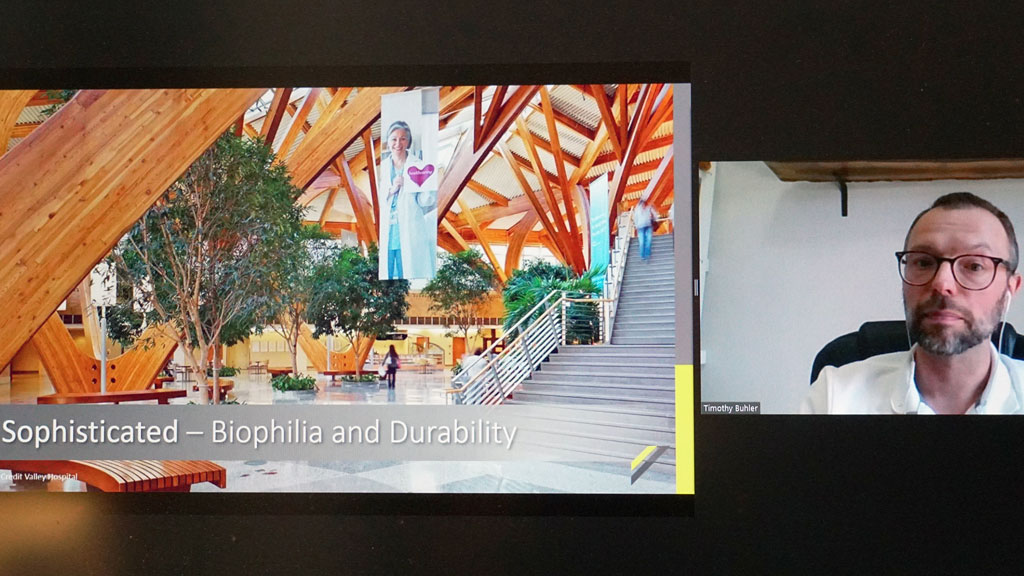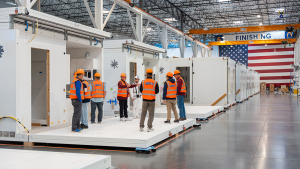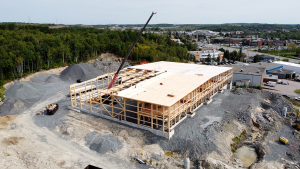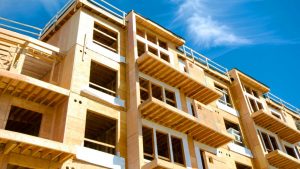As the demand for mass timber construction grows in Canada some question whether the supply can keep pace.
Tim Buhler, technical manager, Canadian Wood Council, Wood WORKS! Ontario, is confident it can. At a recent webinar on mass timber, he pointed out that of the 76 million hectares of forests in Ontario, more than 27 million hectares is certified (monitored by a third party) and less than a half per cent of those are harvested for construction and product use.
“Sustainable harvesting methods ensure that more trees are planted than harvested,” Buhler said at the webinar called Timber Talk: Community Projects in Timber.
Buhler’s presentation covered a broad array of case studies in Canada built in timber, including recreational centres, libraries and administration facilities.
“It’s a really exciting time to be in the wood industry,” he said, noting the field is grabbing attention across Canada and elsewhere. “Every day we see more buildings around the world such as shipping warehouses, skyscrapers and airport terminals being built incorporating larger amounts of timber construction.”
A 25-storey mass timber office building under construction in Milwaukee is one of the latest high profile examples, he said, adding the 2020 edition of the National Building Code of Canada will allow up to 12-storey structures in mass timber, a percentage of which must be encapsulated for fire protection.
Meanwhile, in France all publicly-funded buildings are required to contain at least 50 per cent timber and the B.C. and Quebec governments have “wood first” initiatives in place to encourage designers to use wood.
Buhler encouraged design teams to consider timber, regardless of project size. He cited the 800 square foot P&G Pavilion in Brockville, Ont. as an example of a small but successful project.
He told the webinar the field’s growth will bring more employment to Canadians. In Ontario, 155,000 people are employed directly or indirectly by the forest industry.
“There is a definite economic benefit in advancing timber construction.”
Furthermore, he said as product and technological advancements accelerate, design options for architects will open up.
Mass timber’s eco-friendly benefits are another reason these products can be expected to grow quickly in the green economy. Timber requires five times less energy to produce than concrete and about 24 times less than steel.
Replacing a cubic metre of concrete with one cubic metre of timber prevents the release of one tonne of carbon dioxide from releasing into the atmosphere, he told the webinar.
Durability is also a factor in its success, he adds, noting modern construction methods can enhance the longevity of wood products. The Remington YMCA in Calgary employs timber king post trusses over the swimming pool partly because of practicality/economics, but also because the posts resist degradation caused by the high humidity environment.
Buhler pointed out that studies reveal timber interiors, wood flooring, panelling and furniture, for example, have a positive (biophilic) effect on building occupants. In some medical centres with mental health components patients are happier, their stays are shorter and workers exhibit less stress and are more productive.
As for the soaring prices of timber and wood products, Buhler said as pandemic restrictions ease and the economy regains its footing, he believes the high price of wood products and other construction materials will start to decline and eventually “normalize.”











Recent Comments
comments for this post are closed